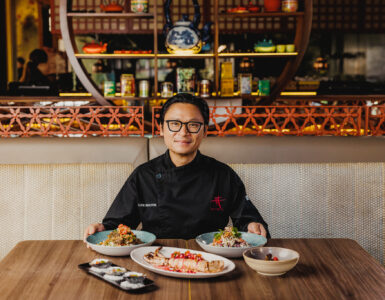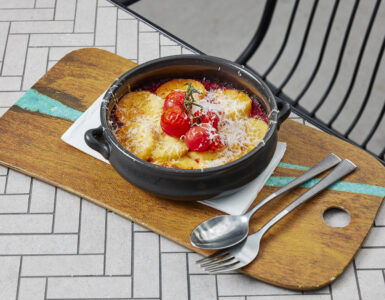Cucina Porto has always been known for its traditional Italian fare – but in a new move, Executive Chef Martino Pulito is putting a fresh new spin on his well-loved dishes with unexpected ingredients: native Australian flora and fauna. Read on to find out how.
We’ve partnered with delicious on a content series that uncovers the deeper stories behind some of The Star’s signature dining venues. In this piece, Martino Pulito, Executive Chef of Cucina Porto at The Star Sydney shares the secrets behind his new native-infused dishes and why local really is best.

In the culinary world, Italy is well-known for prioritising tradition and provenance – something that has led to the cuisine’s worldwide regard.
But that doesn’t mean forgoing creativity. While some Italian chefs swear by using tomatoes from Naples or olive oil from Tuscany, for instance, Executive Chef of Cucina Porto, Martino Pulito believes there’s room to stray a bit without sacrificing the integrity Italian food is known for.
“Italian cuisine is one of the most favoured around the world because we try to keep it simple, find the best produce and don’t mix it up, don’t do crazy things,” says Pulito.

“I want to bring a little bit of innovation to classics that have been there for centuries without destroying the culture, which my mum and nonna taught me.”
At Cucino Porto, he strikes that balance by thoughtfully and subtly introducing native Australian ingredients throughout his otherwise traditional menu. In doing so, he aims to expose diners to the abundance of indigenous ingredients on their doorstep and highlight the best produce and suppliers that Australia has to offer.
“I wanted to keep the concepts but at the same time discover using native ingredients in Australia,” says Pulito. “The point is to create a wow factor in the Australian community.”
For Pulito, that means embracing subtle swaps that feel innovative while still aligning with Italian culture. His goal is to adopt new ingredients while maintaining the same flavour profiles you’d find in his home country and, perhaps even more importantly, providing the same emotional experience one would get when eating the original dish.
In his limited-edition Moreton Bay bug dish, created exclusively for American Express delicious. Month Out, Pulito swaps citrus for lemon myrtle leaves, complementing the bug’s sweet, rich flavour while showcasing the versatile, aromatic crop.
“It looks similar to a bay leaf but when you infuse it in water, it gives you a lemony flavour without needing to add any extra citrus,” says Pulito.
Meanwhile, Pulito spices up his carbonara with native pepper berry as a stand-in for black pepper. Though he adamantly sticks to tradition with this plate, the pepper berry gives it a distinct edge.
“If you change guanciale to bacon, it’s a completely different flavour,” he says. “It doesn’t make sense to my culture. But if I substitute items like I did with the pepper, I’m not compromising the flavour of the dish in general, I’m just changing little ingredients within it.”

At Cucina Porto and beyond, Pulito is setting out to prove that the applications of native ingredients are far-reaching, from savoury dishes all the way through to dessert.
In Italy, panna cottas are often topped with berry compotes or jams. But in his version, also created for American Express delicious. Month Out, he subbed imported fruit for a combination of Davidson plum, riberry and rosella flower, three ingredients that are all native to Australia.
“When you put them together, they create magic without adding anything crazy to the dish,” says Pulito.
The plums are used in a meringue that Pulito scatters around the dish. The riberry, a tart and slightly spiced fruit, is made into a coulis and the rosella, a species of the hibiscus family, is combined with rhubarb and infused into a honey syrup.
“Rosella flower is an amazing product that’s only available a few months a year,” says Pulito.
The base of the dish is made with sheep’s milk sourced from Meredith Dairy, providing a lighter, airier texture than the typical panna cottas found across Italy.
By emphasising a range of local farmers and producers, Pulito hopes to put Australian ingredients on the map and create a case for using more native Australian ingredients in restaurants and at home.
“I truly believe in the next 20 years, 50 years, as more chefs start using Australian natives, they will slowly become part of the Australian culinary culture.”
Though Italian food may be known for its focus on origin and tradition, Pulito and his work at Cucina Porto prove that there’s room to be creative within those confines. For a taste of Chef Martino spin on Italian Australian flavours, visit Cucina Porto seven days a week for lunch or dinner.

This article originally appeared on the delicious. website here.






